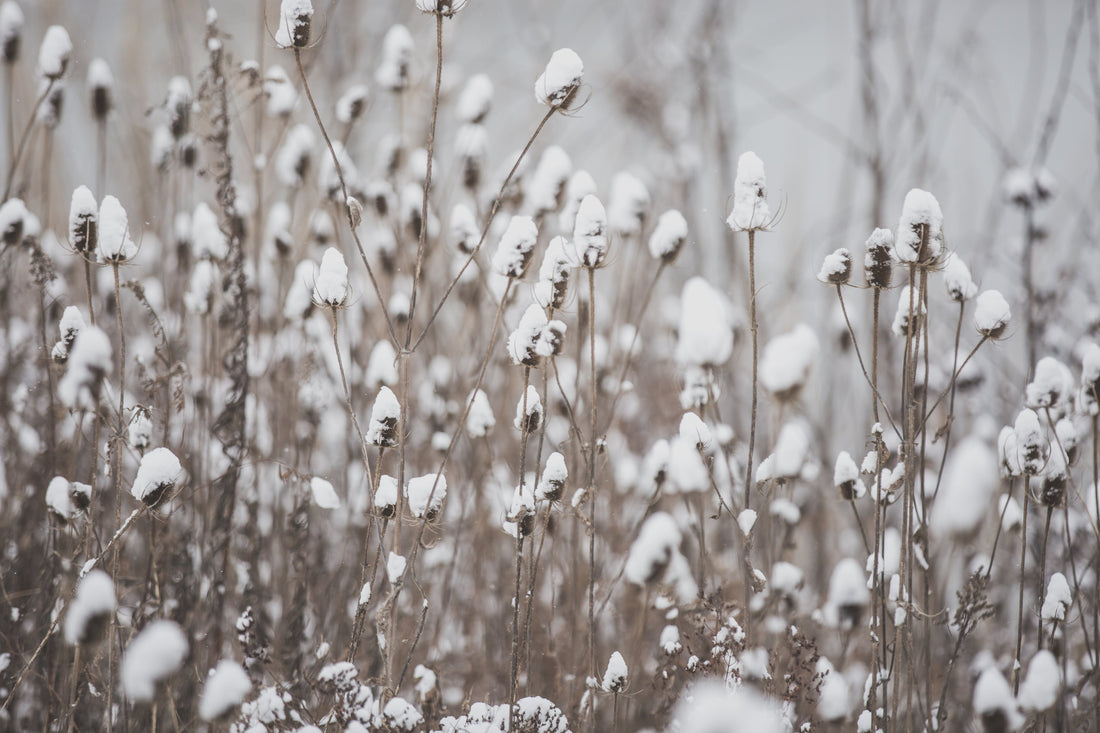Northern Hemisphere – December 20th or 21st
Southern Hemisphere – June 20th or 21st
Winter Solstice
The winter solstice marks the longest night and the shortest day of the year. It is a time when our world is shrouded in darkness before the gradual return of the light as the days begin to lengthen. In herbal traditions, the winter solstice is aligned with the concept of renewal, protection and the potential for inner growth. It is a time to let go of unwanted thoughts, habits or emotions, making way for new beginnings as we head towards spring.
The winter solstice is a time to add a touch of magic into our lives through the use of warming herbs that soothe us and keep us healthy during the cold winter months. Winter solstice herbs possess unique properties that make them particularly suitable for this time of year. They also allow us to observe the beauty of the natural world and see how we are connected to the rhythms of nature. From the warming aroma of rosemary to the soothing properties of chamomile, these winter solstice herbs offer numerous possibilities for enhancing our well-being.

Bay leaves (Laurus nobilis)  also known as sweet bay and laurel, is an easily accessible herb which can be added to warming soups, stews, or savoury pie fillings. Bay leaves have anti-inflammatory and antibacterial qualities and can be infused to relieve indigestion, colic and flatulence. They can also be used to stimulate appetite.
also known as sweet bay and laurel, is an easily accessible herb which can be added to warming soups, stews, or savoury pie fillings. Bay leaves have anti-inflammatory and antibacterial qualities and can be infused to relieve indigestion, colic and flatulence. They can also be used to stimulate appetite.
Spiritually, bay leaves are said to provide wisdom and let you lean into your dreams, both in reality and in sleep. This herbal ally was previously used for manifestation rituals and winter solstice ceremonies. Try making a bay leaf wreath to give a beautiful and fragrant touch to any space. Hang on a door, above the fireplace, in a window or the kitchen to add a fresh, festive element to any room during winter solstice celebrations.

Chamomile (Matricaria chamomilla) is often associated with the winter solstice as its beautiful white and yellow flowers holds the warmth of the sun. The calming and soothing properties of chamomile means it is the perfect herb for long, cold winter nights. A classic herb for an upset stomach, nausea, and indigestion, chamomile provides a sense of peace and cheerfulness in the body through its nervine qualities offering relaxation and promoting restful sleep.
Cinnamon (Cinnamomum verum) with its warm and spicy aroma, is often associated with warmth, protection, and prosperity. Cinnamon was commonly used as a protective herb in winter solstice traditions to defend the home and provide good luck, as well as to represent fire and light. Its inclusion in rituals and recipes during the winter solstice is believed to bring about feelings of abundance and positivity.
My favourite way to enjoy cinnamon is in chai tea, a true gem in the world of beverages. This recipe embraces the warming spices of cinnamon, clove, ginger and cardamom providing a warm embrace, perfect for those chilly winter mornings or as a comforting and relaxing evening treat. Not only does the combination of these warming spices tempt the taste buds, they also provide a number of health benefits, from aiding digestion to boosting the immune system.
Chai Tea
Grind five cloves, five cardamon pods and one cinnamon stick in a mortar and pestle. Place spices in a pot with three teaspoons of black leaf tea, eight teaspoons of sugar, half a teaspoon of grated ginger and 500 millilitres of water. Bring to the boil and simmer for 30 seconds. Add 500 millilitres of milk and bring almost to the boil. Strain and enjoy.

Thyme (Thymus vulgaris) is extremely fragrant and rich in essential oils, and is a staple in cooking, bringing a warm and pungent flavour to food.

The leaves can be used as part of bouquet garni in soups and stews and can also be used in stuffings and savoury dishes. The antimicrobial and antispasmodic properties of thyme makes this herb especially useful in winter. It can be used in teas, bronchial steams and cough syrups to provide relief from colds, coughs and sore throats.
Thyme is also associated with purification, courage, and strength and is known as a protective herb, providing defence against negative energy and influences.
Rosemary (Salvia rosmarinus) often referred to as an “herb of the sun”, symbolises remembrance, loyalty and fertility. Rosemary pairs well with root vegetables like potatoes and carrots, adding a fragrant aroma to roasted dishes. A drink of rosemary tea will restore your body’s inner warmth and fire for life. Rosemary is restorative to all of our blood organs such as the liver, heart, spleen, and kidneys, bringing back balance after a period of fatigue. The aroma has also been linked to improving mood, clearing the mind and relieving stress.
Incorporating rosemary into your winter solstice celebrations could take the form of hanging a wreath of rosemary on a door or incorporating it into a wreath of pine and other evergreens. Use rosemary to decorate the main dish on the solstice table or combine the essential oils of rosemary, orange and cinnamon in a burner to scent the home.

Final thoughts
No matter how you choose to embrace the magic of herbs during the winter solstice, be reminded of the deep connection we share with our natural world and the cycles of our planet. Honour the darkness and the light within and around us and celebrate the innate beauty of our world and those we love within it.


